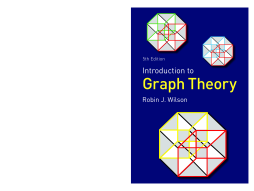
Additional Information
Book Details
Abstract
In recent years graph theory has emerged as a subject in its own right, as well as being an important mathematical tool in such diverse subjects as operational research, chemistry, sociology and genetics. Robin Wilson’s book has been widely used as a text for undergraduate courses in mathematics, computer science and economics, and as a readable introduction to the subject for non-mathematicians.
The opening chapters provide a basic foundation course, containing definitions and examples, connectedness, Eulerian and Hamiltonian paths and cycles, and trees, with a range of applications. This is followed by two chapters on planar graphs and colouring, with special reference to the four-colour theorem. The next chapter deals with transversal theory and connectivity, with applications to network flows. A final chapter on matroid theory ties together material from earlier chapters, and an appendix discusses algorithms and their efficiency.
Table of Contents
| Section Title | Page | Action | Price |
|---|---|---|---|
| Cover\r | Cover | ||
| Introduction to Graph Theory | i | ||
| Contents | v | ||
| Preface to the fifth edition | vii | ||
| Introduction | 1 | ||
| Definitions and examples | 8 | ||
| Definitions | 8 | ||
| Examples | 18 | ||
| Variations on a theme | 22 | ||
| Three puzzles | 26 | ||
| Paths and cycles | 32 | ||
| Connectivity | 32 | ||
| Eulerian graphs and digraphs | 40 | ||
| Hamiltonian graphs and digraphs | 47 | ||
| Applications | 52 | ||
| Trees | 61 | ||
| Properties of trees | 61 | ||
| Counting trees | 65 | ||
| More applications | 70 | ||
| Planarity | 80 | ||
| Planar graphs | 80 | ||
| Euler’s formula | 86 | ||
| Dual graphs | 91 | ||
| Graphs on other surfaces | 96 | ||
| Colouring graphs | 101 | ||
| Colouring vertices | 101 | ||
| Chromatic polynomials | 107 | ||
| Colouring maps | 111 | ||
| The four-colour theorem | 117 | ||
| Colouring edges | 122 | ||
| Matching, marriage and Menger’s theorem | 128 | ||
| Hall’s ‘marriage’ theorem | 128 | ||
| Menger’s theorem | 134 | ||
| Network flows | 138 | ||
| Matroids | 145 | ||
| Introduction to matroids | 145 | ||
| Examples of matroids | 149 | ||
| Matroids and graphs | 152 | ||
| Appendix 1: Algorithms | 158 | ||
| Appendix 2: Table of numbers | 161 | ||
| List of symbols | 162 | ||
| Bibliography | 163 | ||
| Solutions to selected exercises | 166 | ||
| Index | 181 |
